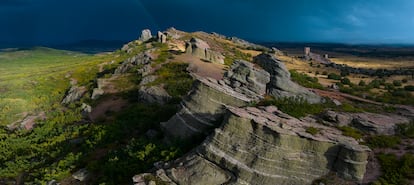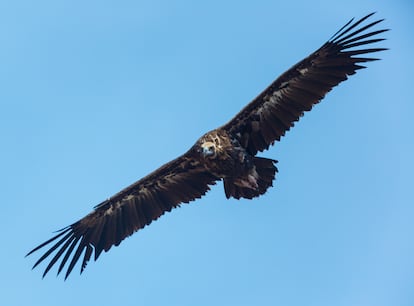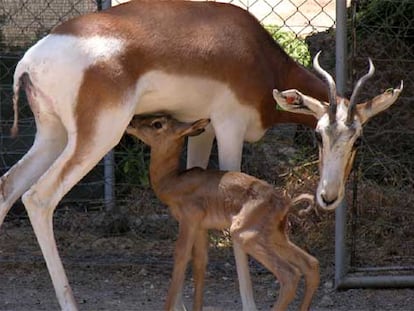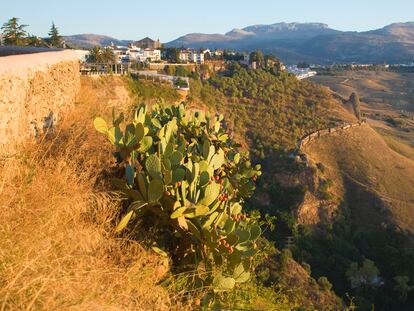Dutch foundation funds large-scale project to rewild deserted area of Spain
Rewilding Europe chose a territory with a population density as low as Mongolia’s for Iberian Highlands, where they hope to introduce a supersized breed of cattle based on the extinct Aurochs


“We have chosen this area because, being very large and uninhabited, in the future it could become a first-rate natural space. Surely outside of Scandinavia there is no area in Europe with such a small population density: two inhabitants per square kilometer, the same as Mongolia.” This is how Deli Saavedra, Head of Landscapes at Rewilding Europe, explains the primary reason why this organization selected a vast tract of land stretching across the Spanish provinces of Guadalajara, Cuenca and Teruel for a large-scale experiment to bring back wildlife.
The large-scale project, named Iberian Highlands, was officially launched on Wednesday in Cuenca and integrates various actions to support wildlife comeback, help restore degraded habitats and boost local economies through nature tourism. Encompassing 850,000 hectares, it is the Dutch foundation’s 10th European project and its first in Spain. The three-year strategy envisions initiatives such as the introduction of Tauros, a bovine breed in the likeness of the ancient aurochs.
“The high levels of biodiversity and low levels of human disturbance provide promising conditions for nature tourism to play a greater role in diversifying and strengthening local economies,” says the group on its project website, describing the area as “a rugged mountain chain of high plateaus that carves its way through the Iberian Peninsula of Spain, home to pine, oak and juniper forests that mingle alongside steppe and dramatic river canyons.”
Saavedra notes that the second reason for choosing this area “is that it is one of the few where other uses of livestock can be demonstrated on a large scale today.” Until now, he says, cattle have been used to produce meat or milk. But Rewilding Europe wants to make these animals one more element of the ecosystem, providing the natural grazing that once helped reduce the risk of wildfires and contributing a positive impact on carbon storage and climate change resilience. “We don’t call them cattle, they are large herbivores working for the ecosystems,” says Saavedra.
In order to carry out this initiative, the Dutch foundation created Rewilding Spain. Its secretary general, the lawyer Mara Zamora, explains that the project has an initial funding of €2.7 million for the first three years, but is planned for a much longer term. The money comes from the Dutch foundation through two sources: a British program for large-scale conservation projects called Endangered Lanscapes Programme, and a foundation owned by Cartier, the watch brand.
Iberian Highlands contemplates various pilot projects in scattered locations where the environmental group will pay either for the rental of pastures or to avoid forest exploitation that damages well-preserved areas. The land falls within three major natural areas: the Alto Tajo and Serranía de Cuenca natural parks, and the Montes Universales hunting reserve, encompassing a combined 850,000 hectares.
Some of specific actions underway include the restoration of natural grazing through the introduction of horses in Mazarete and Villanueva de Alcorón (Guadalajara) and of Tauro bovines in Frías de Albarracín (Teruel). The group is also working to restore scavengers to the area by continuing efforts to bring back the Cinereous vulture “to help restore broken links in the trophic chain.” The demolition of at least one obsolete dam on the Cabrillas River and compensating the owners of old-growth forests for the loss in timber revenues are also under consideration.

“Rewilding Europe works with large landscapes, but obviously it is impossible to work in all this space at the same time, so what we do is launch pilot actions that are also demonstrations for the local residents,” says Saavedra. “We neither impose anything nor do we want livestock or agriculture to disappear from where it is. The problem is that there are many places where there is no longer any of this going on.”
In the case of the Tauros, the project it is expected to incorporate a herd of 24 animals that already live in the Frías de Albarracín area, introduced 17 months ago by Ricardo Almazán, the manager of an animal park called La Maleza. “After 17 months the ground is already changing a lot, because the Tauro is an animal that eats lignified vegetation, bushes with woody stems; literally, it eats wood,” says Almazán, emphasizing the importance of this in fighting wildfires. “A beef cow has to be fed for eight or nine months out of the year, otherwise it will die. But these Tauros take advantage of the natural resources, feeding on what they find, whatever the weather, without ever getting sick.”
Almazán explains that the Tauro is a bovine that has been bred deliberately to resemble the extinct aurochs, which roamed Europe until the early 17th century. Another Dutch foundation, Stichting Taurus, has been instrumental in the breeding program, which began in 2009 by crossing different types of Europe’s hardiest known bovines (including three Spanish breeds, the Limia, the Sayaguesa and the Pajuna del sur). “The Tauro is an animal that reaches up to 1,000 kilos, is about 1.80 meters tall at the withers (where the neck begins) and has its horns always pointing upwards, as the aurochs had,” says Almazán. “It’s not a dangerous animal at all, but Tauro projects can only thrive in places devoid of humans, because a thousand-kilo critter is scary.”

Last year, a group of scientists issued a warning about the risks of introducing European bison in parts of the Iberian peninsula, where it had never lived before. In the case of the Tauros, Almazán points out that “it cannot be said that it is an exotic species, since the Tauro is a bovine with current European cow genes, especially adapted to European ecosystems, and what is intended is the recovery of a key species that once lived here and that we eliminated.”
For the mayor of Frías de Albarracín, Benito Lacasa, “managing these animals is not difficult, but it is not easy either.” “Although we have a small population in these mountains, there are still people in these municipalities, there is farmland, sheep farming, wood harvesting and other activities, so the Tauros must be compatible with all these activities, it is not about using the space exclusively for these animals.” Lacasa explains that an area of about 500 hectares near the municipality has been fenced off so it does not interfere with other activities. “We have done this with two purposes: one is scientific, to see the changes that these animals produce in the landscape, in the pastures, in the insects; and the other is to see if there is any tourist interest to come and see these Tauros.”









































